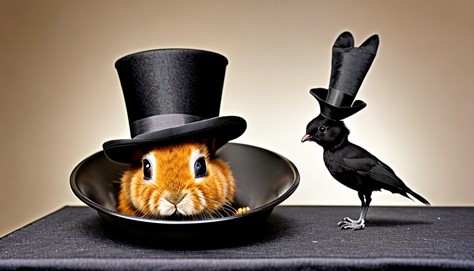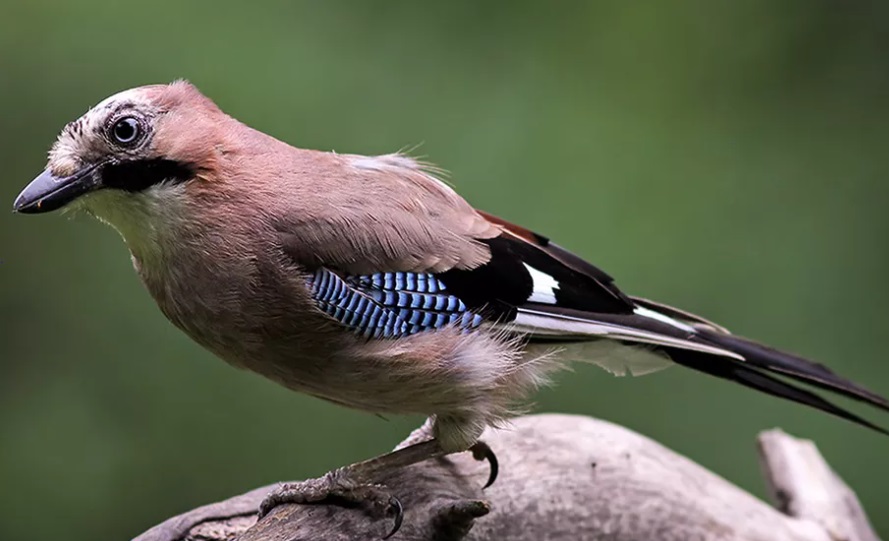By Saulo Silvestre and Mariana Meneses
Chances are that you have fallen for a magic trick at least once in your life.

Image generated using Getimg.Ai.
The way that talented and professional illusionists exploit our biases in attention and perception to prevent us from seeing what’s in front of our eyes is just… well, science. It turns out that we can learn a lot about how our minds work by scientifically investigating the neurological effects of magic.
Psychologists have long been interested in how magic tricks can deceive us humans.
A group of scientists at the University of Cambridge believes that including other animals in their research will provide insights into the common features of attention and perception that we share with other species. They expect that research like theirs could help shed light on the question of how unique the human mind is.
Scientists had already begun using magic tricks to investigate blind spots in our attention and perception, but little is known about how these effects might affect other animals. A group of researchers led by Dr. Nicola Clayton at the University of Cambridge believes we could have an even broader perspective on how the mind works by comparing humans with other animals. They teamed up with magician Clive Wilkins, artist-in-residence at the department of psychology, to perform magic tricks for birds and reveal their modes of thinking and flaws in perception. They chose Eurasian jays as their first subjects for testing animals’ cognitive abilities through visual illusions that usually fool us humans.

Eurasian Jay. Photo: The Spruce
Eurasian jays (Garrulus glandarius) are known for their highly developed intelligence.
One could say that they are a kind of magicians themselves. In the wild, they’ve shown behaviors such as pretending to hide food in multiple places in order to fool competitors who might want to steal from them. As a result, researchers thought they would be a good starting point to investigate cognitive processes during optical illusions in animals.
They tested the susceptibility of six Eurasian jays to be misled by three different magic tricks. These tricks used different cues and expectations but had one common purpose: to make the subject believe that one object had (or not) been transferred from one hand to another. By varying the cues and expectations, but maintaining a common purpose, scientists can infer how different cognitive abilities are related to falling or not for a specific magic effect.

Illustration of a magic trick. Image: PxHere
In one of these experiments, team member Elias Garcia-Pelegrin, who was then PhD candidate at the department of psychology and a magician, performed a series of tricks by hiding a worm in one hand and training the birds to find it. He would pretend to have grabbed the worm with the other hand, and waited to see if the bird had picked up on it. Surprisingly, even though he is usually successful in fooling humans, Eurasian jays were not so easily misled.
The reason for this? It seems like the birds did not fall for that trick because they did not have the same expectations as humans, who would normally think that the hand movements indicate that the object had changed hands.
Although the birds were not deceived by the tricks that required them to expect an object to change places due to human hand manipulation, they were successfully misled by other magic effects that relied on fast movements for deception. Thus, Eurasian jays are susceptible to some magic tricks, but not the ones that require expectations about manipulation of objects by humans. This evidence suggests that the susceptibility to being fooled relies on the observer’s expectations, which in turn relies on their previous knowledge.
Comparative psychologists had already used deception to investigate how animals think.
But this was the first study to use tricks designed to fool the human mind to compare differences of attention and perception in other animals. Such illusions highlight animals’ powers of perception, and their ability to remember the past and anticipate the future. This approach proved to be a unique opportunity to understand cognitive constraints in diverse minds.
Professor Clayton told The Quantum Record that “Magic effects reveal blind spots in seeing and roadblocks in thinking, and because they rely on perceptual effects, they provide an important tool for studying cognitive constraints in non-verbal animals as well as humans.” She explained that ‘magic’ happens in the minds of the audience. It relies on the audience’s perception and memory of what they believe they witnessed, what they believe occurred, and their expectations of where they think the object of interest is. This applies whether it’s a coin trick for humans or a food reward for non-human animals. In other words, the audience’s imagination and interpretation play a significant role in creating the magical experience, as they construct their own version of events based on their beliefs and expectations.

Illustration of the human mind at work. Photo: MaxPixel
In a recent study, Garcia-Pelegrin, who is currently an Assistant Professor at the National University of Singapore, and his co-authors expanded on earlier research to investigate the captivating nature of magic tricks and their effects on humans. They aimed to explore whether the feelings of wonder and disbelief that arise from witnessing magic are exclusive to our species, or if other animals also experience them.
The researchers delve into the deceptive tactics employed by advanced nonhuman animals, such as apes, corvids (like crows and ravens), and cephalopods (like octopuses), and draw parallels between their techniques and those used by magicians. By considering how animals exploit similar perceptual blind spots and memory limitations, the researchers argue that studying magic in comparative psychology can shed light on fascinating psychological constraints across diverse animal minds, potentially offering insights into questions about consciousness.
To Garcia-Pelegrin, the first step in these studies is understanding why a trick works in humans. Then, scientists can see why it works or not in other species, and this teaches us about their vision, attentional and perceptive systems. Studies like this one offer a window into the minds of animals. They reveal gaps in perception and attention, and remind us of how our interpretations and beliefs, extracted from what we see, are deeply dependent on our expectations of time which are shaped by previous experiences.
Taking it a step further, our expectations are influenced by our shared human condition, but this also means that we can alter them by gaining knowledge and experience. Ultimately, the human mind may be just as exceptional as the diverse range of experiences it encounters.
Keen to explore further?
Dive into our vast TQR article collection exploring the enigmatic realms of mind and consciousness. Engage with captivating discussions on thought-provoking topics such as,
- The Science of Consciousness: Have We Finally Solved the Mystery Inside Our Heads?
- Study Identifies Brain Region That May Store Our Sense of Self
- Mind Reading Technology Connects Brains to Machines




In recognising the hidden objects , the role of smell senses of other animals / birds in comparison of humen beings should also be taken into consideration!